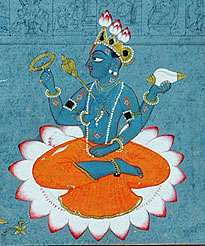Tulsi Vivah
Tulasi Vivaha is the ceremonial marriage of the Tulasi or commonly Tulsi (holy basil) plant to the Hindu god Shaligram or Vishnu or to his avatar, Sri Krishna. The Tulsi wedding signifies the end of the monsoon and the beginning of the wedding season in Hinduism.[1][2]
| Tulsi Vivah | |
|---|---|
Tulasi Vivaha ceremony | |
| Observed by | Hindus |
| Type | Religious |
| Celebrations | 1 day |
| Begins | Prabodhini Ekadashi |
| Ends | Kartik Poornima |
| Frequency | Annual |
The ceremonial festival is performed anytime between Prabodhini Ekadashi (the eleventh or twelfth lunar day of the bright fortnight of the Hindu month of Kartik) and Kartik Poornima (the full moon of the month). The day varies regionally.[3][4]
Legend


Tulsi is venerated as a goddess in Hinduism and is sometimes considered as a wife of Vishnu, with the epithet, “Vishnupriya”, “the beloved of Vishnu”. The legend behind Tulsi Vivah and its rites are told in the scripture, Padma Purana.[5]
According to Hindu scripture, the Tulsi plant was a woman named “Vrinda” (Brinda; a synonym of Tulsi). She was an incarnation of the Goddess Lakshmi. She was married to the Asura king Jalandhar, who due to her piety and devotion to Vishnu, became invincible. Even Devtas could not defeat Jalandhar, so they requested Vishnu - the preserver in the Trinity - to find a solution. When leaving for war Vrinda promised Jalandar for doing Sankalpa for his victory till he returns but Lord Vishnu disguised himself as Jalandhar and she saw him ,she left her sankalp and touched his feet.
With her Sankalpa destroyed, Jalandhar lost his power and was killed by Shiva.and his head fell in Vrinda's palace.
Seeing this she realized it was not her husband but Lord Vishnu.
Vrinda cursed Lord Vishnu to become Shaligram and to be separated from his wife, Lakshmi. This was later fulfilled when he was transformed into the black Shaligram stone (actually a fossil), and in his Rama avatar, was separated from his wife Sita, who was kidnapped by the asura king Ravana. Vrinda then drowned herself in the ocean, and the gods (or Vishnu himself) transferred her soul to a plant, which was henceforth called Tulsi.
As per a blessing by Vishnu to marry Vrinda in her next birth, Vishnu – in form of Shaligram - married Tulsi on Prabodhini Ekadashi. To commemorate this event, the ceremony of Tulsi Vivah is performed.[1][2]
Another minor legend narrates that Lakshmi slew a demon on this day and remained on earth as the Tulsi plant.[3]
Celebrations
The marriage of Tulsi with Vishnu/Krishna resembles the traditional Hindu wedding.[1][2] The marriage ceremony is conducted at homes and at temples where a fast is observed on the Tulsi Vivah day until evening when the ceremony begins. A mandap (marriage booth) is built around the courtyard of the house where the Tulsi plant is usually planted in centre of the courtyard in a brick plaster called the Tulsi vrindavana. It is believed that the soul of Vrinda resides in the plant at night and leaves in the morning.[3] The bride Tulsi is clothed with a sari and ornaments including earrings and necklaces. A human paper face with a bindi and nose-ring may be attached to Tulsi. The groom is a brass image or picture of Vishnu or Krishna or sometimes Balarama or more frequently the Shaligram stone - the symbol of Vishnu. The image is clothed in a dhoti. Both Vishnu and Tulsi are bathed and decorated with flowers and garlands before the wedding. The couple is linked with a cotton thread (mala) in the ceremony.[2]
In India

At Prabhu Dham in Saunja, India, the festival is collectively celebrated by whole village which makes it a significant point of attraction. Here it is celebrated as three day festival in the Hindi month of Kartik from Ekadashi to Trayodashi. The festival is started with the vedic chanting of Ramcharitmanas or Ramayana by the villagers itself. The second day is celebrated as Sobha Yatra which is of significant importance in which the special prasad is Pongal, and the third day is celebrated as Tilakotsav and Vivahotsav of Lord Vishnu and Devi Brinda. The villagers prepare 56 types of prasad known as Chapan Bhog and distributed to all. All caste takes participation in this village accordingly. Devoties including saints and mahants all over from Bihar visit this place to celebrate this festive occasion.
In Maharashtra, an important ritual in the ceremony is when the white cloth is held between the bride and the groom and the priest recites the Mangal Ashtaka mantras. These mantras formally complete the wedding. Rice mixed with vermilion is showered by the attendees on Tulsi and Vishnu at the end of the recitation of the mantras with the word "Savadhan" (literally "be careful" implying "You are united now". The white curtain is also removed. The attendees clap signifying approval to the wedding. Vishnu is offered sandalwood-paste, men's clothing and the sacred thread. The bride is offered saris, turmeric, vermilion and a wedding necklace called Mangal-sutra, worn by married women. Sweets and food cooked for an actual wedding are cooked for Tulsi Vivah too. This ceremony is mostly performed by women.[3][1] The prasad of sugar-cane, coconut chips, fruits and groundnut is distributed to devotees.
The expenses of the wedding are usually borne by a daughter-less couple, who act as the parents of Tulsi in the ritual wedding. The giving away of the daughter Tulsi (kanyadaan) to Krishna is considered meritorious to the couple. The bridal offerings to Tulsi are given to a Brahmin priest or female ascetics after the ceremony.[2]
In two Rama temples in Saurashtra, the ceremony is more elaborate. An invitation card is sent to the groom's temple by the bride's temple. On Prabodhini Ekadashi, a barat bridal procession of Lalji - an image of Vishnu - sets off to the bride's temple. Lalji is placed in a palanquin and accompanied by singing and dancing devotees. The barat is welcomed on the outskirts of Tulsi's village and the ceremonial marriage is carried at the temple. At the bride's side, Tulsi is planted in an earthen pot for the ceremony. People desirous of children perform Kanyadaan from Tulsi's side acting as her parents. Bhajans are sung throughout the night and in the morning the barat of Lalji returns to their village with Tulsi.
See also
- Tulsi in Hinduism
- Tulsi Pujan Diwas
References
- R. Manohar Lall (1933). Among the Hindus: A Study of Hindu Festivals. Asian Educational Services. pp. 184–. ISBN 978-81-206-1822-0.
- Emma Tarlo (1996). Clothing Matters: Dress and Identity in India. University of Chicago Press. pp. 184–5. ISBN 978-0-226-78976-7.
- M.M. Underhill (1991). The Hindu Religious Year. Asian Educational Services. pp. 129–131. ISBN 978-81-206-0523-7.
- Shubhangi Pawar; D. A. Patil (2008). Ethnobotany of Jalgaon District, Maharashtra. Daya Publishing House. p. 400. ISBN 978-81-7035-515-1.
- Manish Verma (2005). Fasts & Festivals Of India. Diamond Pocket Books. pp. 58–. ISBN 978-81-7182-076-4.
